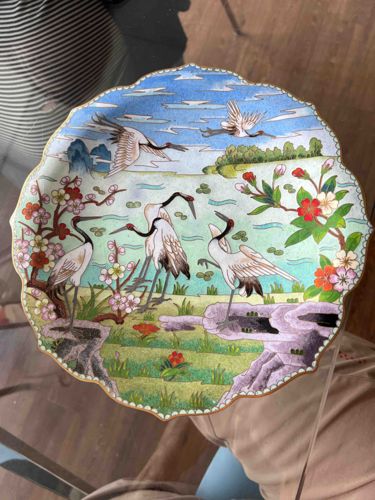
Cloisonné Plate with Cranes and Landscape Scene
This is a cloisonné plate or charger featuring a scene of red-crowned cranes (Grus japonensis) in a landscape. The plate has a scalloped edge and appears to be made of brass or copper with enamel applied in the cloisonné technique. The background depicts a calm body of water, possibly a lake or pond, under a vibrant blue sky with layered clouds. The landscape includes rocky outcrops, green grass, and trees in bloom. Five cranes are depicted in various poses, some standing on the rocks, some wading, and one flying through the sky. The colors are vibrant and include shades of blue, green, yellow, brown, white, black, and red in the flowers and the cranes' crowns. The quality of the enamel work appears to be good, with clear cell work and rich colors. There are no visible condition issues such as chips, cracks, or significant wear, although the image quality makes it difficult to assess fine details. The overall style suggests an Asian origin, likely Chinese, and based on the level of detail and the materials, it could date from the late 19th to mid-20th century.
AI-Generated Appraisal Disclaimer
Estimated Value
$400-600
Basic Information
Category
Decorative Plate
Appraised On
December 8, 2025
Estimated Value
$400-600
Item Description
This is a cloisonné plate or charger featuring a scene of red-crowned cranes (Grus japonensis) in a landscape. The plate has a scalloped edge and appears to be made of brass or copper with enamel applied in the cloisonné technique. The background depicts a calm body of water, possibly a lake or pond, under a vibrant blue sky with layered clouds. The landscape includes rocky outcrops, green grass, and trees in bloom. Five cranes are depicted in various poses, some standing on the rocks, some wading, and one flying through the sky. The colors are vibrant and include shades of blue, green, yellow, brown, white, black, and red in the flowers and the cranes' crowns. The quality of the enamel work appears to be good, with clear cell work and rich colors. There are no visible condition issues such as chips, cracks, or significant wear, although the image quality makes it difficult to assess fine details. The overall style suggests an Asian origin, likely Chinese, and based on the level of detail and the materials, it could date from the late 19th to mid-20th century.
Get Your Items Appraised
Instant estimates of your treasures with AI-powered instant appraisals